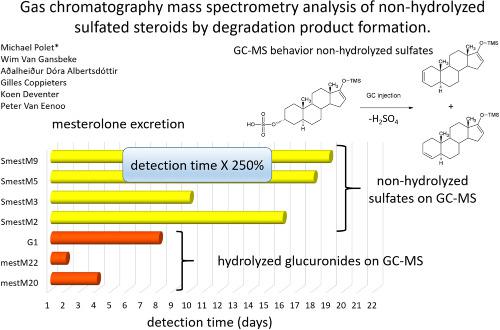当前位置:
X-MOL 学术
›
Drug Test. Anal.
›
论文详情
Our official English website, www.x-mol.net, welcomes your feedback! (Note: you will need to create a separate account there.)
Gas chromatography-mass spectrometry analysis of non-hydrolyzed sulfated steroids by degradation product formation.
Drug Testing and Analysis ( IF 2.9 ) Pub Date : 2019-05-15 , DOI: 10.1002/dta.2606 Michael Polet 1 , Wim Van Gansbeke 1 , Aðalheiður Dóra Albertsdóttir 1 , Gilles Coppieters 1 , Koen Deventer 1 , Peter Van Eenoo 1
Drug Testing and Analysis ( IF 2.9 ) Pub Date : 2019-05-15 , DOI: 10.1002/dta.2606 Michael Polet 1 , Wim Van Gansbeke 1 , Aðalheiður Dóra Albertsdóttir 1 , Gilles Coppieters 1 , Koen Deventer 1 , Peter Van Eenoo 1
Affiliation

|
Steroid detection and identification remain key issues in toxicology, drug testing, medical diagnostics, food safety control, and doping control. In this study, we evaluate the capabilities and usefulness of analyzing non‐hydrolyzed sulfated steroids with gas chromatography−mass spectrometry (GC–MS) instead of the conventionally applied liquid chromatography−mass spectrometry (LC–MS) approach. Sulfates of 31 steroids were synthesized and their MS and chromatographic behavior studied by chemical ionization−GC−triple quadrupole MS (CI−GC‐TQMS) and low energy−electron ionization−GC−quadrupole time‐of‐flight−MS (LE−EI−GC−QTOF−MS). The collected data shows that the sulfate group is cleaved off in the injection port of the GC–MS, forming two isomers. In CI, the dominant species (ie, [MH – H2SO4]+ or [MH – H4S2O8]+ for bis‐sulfates) is very abundant due to the limited amount of fragmentation, making it an ideal precursor ion for MS/MS. In LE−EI, [M – H2SO4].+ and/or [M – H2SO4 – CH3].+ are the dominant species in most cases. Based on the common GC–MS behavior of non‐hydrolyzed sulfated steroids, two applications were evaluated and compared with the conventionally applied LC–MS approach; (a) discovery of (new) sulfated steroid metabolites of mesterolone and (b) expanding anabolic androgenic steroid abuse detection windows. GC–MS and LC–MS analysis of non‐hydrolyzed sulfated steroids offered comparable sensitivities, superseding these of GC–MS after hydrolysis. For non‐hydrolyzed sulfated steroids, GC–MS offers a higher structural elucidating power and a more straightforward inclusion in screening methods than LC–MS.
中文翻译:

通过降解产物的形成对未水解的硫酸化类固醇进行气相色谱-质谱分析。
类固醇的检测和识别仍然是毒理学,药物测试,医学诊断,食品安全控制和掺杂控制中的关键问题。在这项研究中,我们评估了使用气相色谱-质谱(GC-MS)代替常规应用的液相色谱-质谱(LC-MS)方法分析非水解硫酸类固醇的能力和实用性。合成了31种类固醇的硫酸盐,并通过化学电离-GC-三重四极杆质谱(CI-GC-TQMS)和低能电子电离-GC-四极杆飞行时间质谱(LE-EI)研究了它们的MS和色谱行为-GC-QTOF-MS)。收集的数据表明,硫酸根基团在GC-MS的进样口中裂解,形成两个异构体。在CI中,优势种(即[MH – H 2 SO 4对于双硫酸盐而言,] +或[MH-H 4 S 2 O 8 ] +的含量非常高,这是由于碎片数量有限,使其成为MS / MS的理想前体离子。在LE−EI中,[M – H 2 SO 4 ] 。+和/或[M – H 2 SO 4 – CH 3 ] 。+在大多数情况下是优势种。根据非水解硫酸类固醇的常见GC-MS行为,对两种应用进行了评估,并与传统应用的LC-MS方法进行了比较;(a)发现甲固龙的(新)硫酸化类固醇代谢物,以及(b)扩大合成代谢雄性类固醇滥用检测窗口。非水解硫酸类固醇的GC-MS和LC-MS分析提供了相当的灵敏度,水解后取代了GC-MS。对于非水解的硫酸类固醇,与LC-MS相比,GC-MS具有更高的结构解析能力和更直接的筛选方法。
更新日期:2019-05-15
中文翻译:

通过降解产物的形成对未水解的硫酸化类固醇进行气相色谱-质谱分析。
类固醇的检测和识别仍然是毒理学,药物测试,医学诊断,食品安全控制和掺杂控制中的关键问题。在这项研究中,我们评估了使用气相色谱-质谱(GC-MS)代替常规应用的液相色谱-质谱(LC-MS)方法分析非水解硫酸类固醇的能力和实用性。合成了31种类固醇的硫酸盐,并通过化学电离-GC-三重四极杆质谱(CI-GC-TQMS)和低能电子电离-GC-四极杆飞行时间质谱(LE-EI)研究了它们的MS和色谱行为-GC-QTOF-MS)。收集的数据表明,硫酸根基团在GC-MS的进样口中裂解,形成两个异构体。在CI中,优势种(即[MH – H 2 SO 4对于双硫酸盐而言,] +或[MH-H 4 S 2 O 8 ] +的含量非常高,这是由于碎片数量有限,使其成为MS / MS的理想前体离子。在LE−EI中,[M – H 2 SO 4 ] 。+和/或[M – H 2 SO 4 – CH 3 ] 。+在大多数情况下是优势种。根据非水解硫酸类固醇的常见GC-MS行为,对两种应用进行了评估,并与传统应用的LC-MS方法进行了比较;(a)发现甲固龙的(新)硫酸化类固醇代谢物,以及(b)扩大合成代谢雄性类固醇滥用检测窗口。非水解硫酸类固醇的GC-MS和LC-MS分析提供了相当的灵敏度,水解后取代了GC-MS。对于非水解的硫酸类固醇,与LC-MS相比,GC-MS具有更高的结构解析能力和更直接的筛选方法。


























 京公网安备 11010802027423号
京公网安备 11010802027423号